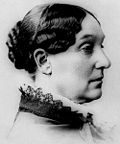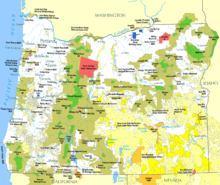- Land use in Oregon
-
Land use in Oregon are the evolving laws affecting land ownership and its restrictions in the U.S. state of Oregon.
Contents
Timeline
- 1822: Henry Schenck Tanner's map of the U.S. is likely the first to identify the "Oregon Terry."[1]
- 1850: Donation Land Act
- 1851: Willamette Stone sited, became the basis for property lines throughout Oregon and Washington.
- 1862: Homestead Act (in effect till 1976, and 1986 in Alaska)
- October 27, 1868: Corvallis College (now Oregon State University) was designated Oregon's first and only Land Grant College under the federal Morrill Land-Grant Colleges Act.
- 1869: Oregon and California Railroad receives land grant from US government with mandate to sell to settlers at $2.50/acre[2]
- 1878: Timber and Stone Act
- 1903: Southern Pacific Railroad, which acquired the O&C railroad, announces it will no longer sell land, in violation of terms of the land grant[2]
- up to 1905: Abuse of land grant process results in Oregon land fraud scandal[2]
- 1907: Three Arch Rocks first National Wildlife Refuge established west of Mississippi[3]
- 1907: Walter Lafferty begins lawsuit on behalf of 18 western Oregon counties affected by the land fraud scandal
- 1913: public access to beaches formalized—originally for use as highways—codified general public understanding under Oswald West[4]
- 1916: U.S. Congress passes Chamberlain-Ferris Act, which established payments to Oregon counties for timber sales on former O&C lands; modified by the Stanfield Act of 1926[5]
- 1937: Congress passes the Oregon and California Railroad and Coos Bay Wagon Road Grant Lands Act of 1937 (O&C Act), which further modifies the terms of the timber payments to O&C counties; payments are reduced in 1953.[5]
- 1933–1951: Fire destroys much of what is now known as the Tillamook State Forest in the Tillamook Burn
- 1961: farm tax deferral
- 1963: Exclusive Farm Use (EFU) zoning
- 1967: Oregon Beach Bill establishes public ownership of land along the Oregon Coast[4]
- Willamette River Greenway
- 1969: Senate Bill 10 required comprehensive land use plans for every city and county.
- Sohappy v. Smith, along with Washington's Boldt Decision, established fishing rights for Native Americans
- 1970: Measure 11 failed (44%)
- 1971: Oregon Coastal Conservation and Development Commission[4]
- 1973: Many county-owned forests, largely owned as a result of property foreclosures, dedicated as Tillamook State Forest
- 1990: The Northern Spotted Owl is listed as threatened as part of the Endangered Species Act; logging on federal lands is ended by court order
- 1993: Congress passes the Omnibus Budget Reconciliation Act of 1993 which replaces timber payments with "safety net" payment to 72 rural counties, including the O&C counties. Payments are to last until 2000.[5]
- 1994: The Northwest Forest Plan is implemented and defines land use on federal lands in the Northwest that sharply reduces timber harvest
- 2000: Congress passes the Secure Rural Schools and Community Self-Determination Act of 2000 (SRSCSDA) (often called the County payments program), which authorizes western counties, including the O&C counties, to receive federal payments to compensate for loss of timber revenue for 6 years[5]Note: 33 of Oregon's 36 rural counties get payments: all but Sherman, Gilliam, Clatsop.
- 2001: Northwest Coastal Forest Plan established, aimed to balance demands on forests in Tillamook and Clatsop counties. Largely regarded as a failure by 2008.[6]
- 2006: SRSCSDA ends and is not reauthorized; as part of another bill, the U.S. Troop Readiness, Veterans' Care, Katrina Recovery, and Iraq Accountability Appropriations Act, 2007, payments were extended another year
- 2007: No extension to SRSCSDA is passed and federal payments to rural Oregon counties end; beginning July 1, 2008 Oregon loses $238 million in federal payments[7]
- 2008: 4-year extension to SRSCDA is surprisingly included in Emergency Economic Stabilization Act of 2008. Rep. DeFazio and Sen. Wyden, two of the biggest supporters of extending the payments to Oregon counties, vote against the bill due to their opposition to the overall bailout bill.[8]
- 2011: The extension to SRSCDA expires on September 30 and the final payments are scheduled for early 2012. Backed by Governor John Kitzhaber and the entire Oregon congressional delegation, Senator Ron Wyden introduces legislation to extend the payments for another five years.[9]
Senate Bill 100
- 1973: Senate Bills 100 and 101 established Oregon Land Conservation and Development Commission, Oregon Department of Land Conservation and Development, etc. Led to adoption of 14 statewide planning goals and created statewide protections for farmland.[10][11][12][13][14][15]
- 1976: Measure 10 failed (39%) Measure 12 sought to repeal SB 100. Failed by 60+%.
- 1978: Measure 10 sought to repeal SB 100. Failed (39% yes)
- 1979: Land Use Board of Appeals (LUBA) created
- 1982: Measure 6 sought to repeal SB 100. Fails (45% yes)
- 1991: PAPA and PR Reform
- 1993: Legislature passes HB 3661 and expands ability to build houses on farm and forestland.
- 1995: Republicans introduce multiple bills that strip SB 100. Democrats stop them.
- 1997: Republicans introduce multiple bills that strip SB 100. Democrats stop them.
- 1998: Measure 65 (sought to roll back land use regulation, failed)
- 1999: Measure 56 passed 80%
- 2000: Measure 2 (sought to roll back land use regulation, failed, 47% yes)
- Measure 7 — an amendment to the Oregon Constitution which is subsequently declared illegal — passed. controversial but uncontested title language(?)
- 2004: Measure 37 passed (61%). controversial, uncontested title language(?)
- 2005–2009: Oregon Big Look Task Force, a citizen commission created by SB 82 of the 2005 session, charged with bringing land use recommendations to 2009 legislature.
- 2007: Measure 49 repeals/modifies much of Measure 37.
See also
- Urban growth boundary
- United States Bureau of Reclamation
- United States Bureau of Land Management
- United States Forest Service
- Gifford Pinchot, Theodore Roosevelt
- Oregon State Land Board
- List of Oregon ballot measures
- Oregonians In Action (led by Dave Hunnicut, backers of "property rights movement" since late '90s?)
- 1000 Friends of Oregon (opposed 37, proponents of 49, very farm-aligned)
- Regulatory taking -- the concept that regulating land use constitutes a "taking" of property value, thus should be considered an exercise of eminent domain
- Oregon Department of State Lands (and the Common School Fund)
References
- ^ Tanner Map of 1822 in the Oregon Encyclopedia
- ^ a b c "Oregon and California Railroad". Oregon Historical Society. 2003. http://www.ohs.org/education/oregonhistory/historical_records/dspDocument.cfm?doc_ID=57DC68B6-D7DF-29DF-E0AEFFF6262C7F98. Retrieved 2008-07-17.
- ^ "Three Arch Rocks Refuge Celebrates Centennial". United States Fish and Wildlife Service. 2007-10-02. http://www.fws.gov/oregoncoast/news/display_blog.cfm?bid=616BB989-DE83-4DE3-CC23BB9B87B55551. Retrieved 2007-11-27.
- ^ a b c Oregon Coastal Management Program (1994). "Part One: Ocean Management Framework A. History of Ocean Planning in Oregon" (PDF). Oregon Territorial Sea Plan. http://www.oregon.gov/LCD/OCMP/docs/Ocean/otsp_1-a.pdf. Retrieved 2007-11-27.
- ^ a b c d Oregon Heritage Forests. "Legal History of O&C Lands". http://www.oregonheritageforests.org/history/legal. Retrieved 2008-07-17.[dead link]
- ^ Millstein, Michael (2008-11-06). "2001 plan for coastal forests isn't working". The Oregonian (Advance Publications). http://0-docs.newsbank.com.catalog.multcolib.org/openurl?ctx_ver=z39.88-2004&rft_id=info:sid/iw.newsbank.com:NewsBank:ORGB&rft_val_format=info:ofi/fmt:kev:mtx:ctx&rft_dat=124508E4ADE2EAF0&svc_dat=InfoWeb:aggregated5&req_dat=0D10F2CADB4B24C0.
- ^ "A blow to every Oregonian". The Oregonian. Advance Publications.
- ^ Preusch, Matthew. "33 Oregon counties will share an unexpected $740 million". The Oregonian. Advance Publications. http://www.oregonlive.com/news/index.ssf/2008/10/33_oregon_counties_will_share.html. Retrieved 2008-10-20.
- ^ "Oregon Leaders Announce County Payments Deal". KTVZ.com. http://www.ktvz.com/news/29398137/detail.html. Retrieved October 5, 2011.
- ^ "History of the Oregon Land Use Planning Program: Presentation to the Task Force on Land Use Planning" (PDF). 2006-03-03. http://centralpt.com/upload/301/1939_sb82histppt030306.pdf.
- ^ "The Evolution of Oregon's Statewide Planning Goals - October 2000" (PDF). Department of Land Conservation and Development. http://www.oregon.gov/LCD/docs/goals/goalsappendix.pdf.
- ^ Wuerthner, George (2007-03-19). "The Oregon Example: Statewide Planning Works". Mountain West Publishing Company. http://www.newwest.net/index.php/city/article/the_oregon_example_statewide_planning_works/C396/L396/. Retrieved 2007-11-27.
- ^ Beggs, C.E. (1973-05-28). "1st statewide planning commission will be created this year". Oregon Statesman. Salem, Oregon: Gannett Company. p. Section 1:6. http://www.orgov.org/beggarticle.html.
- ^ McCall, Tom (1974-01-07). "The Oregon Land Use Story". Executive Department, Local Government Relations Division. http://www.orgov.org/Oregon_Land_Use_Story.pdf.
- ^ "Original text of Senate Bill 100". orgov.org. http://www.orgov.org/landusetext.html.
External links
- Oregon Department of Land Conservation and Development (established by SB 100)
- Land use planning in the Oregon Encyclopedia
- Senate Bill 100 in the Oregon Encyclopedia
Topics in Oregon legislation Crime and sentencing Capital punishment · Measure 11 (1994) (mandatory minimum sentencing) · Measure 40 (1996) etc. (victims' rights) Abigail Scott Duniway was instrumental in establishing women's right to vote in Oregon.
Abigail Scott Duniway was instrumental in establishing women's right to vote in Oregon.
Elections and voting Gay rights Environment Land use Health care Minimum wage Taxation Tax revolt · Measure 5 (1990) (landmark tax law) · Measures 47 (1996) and 50 (1997) (adjusted Measure 5) · Kicker (tax rebate)Miscellaneous Influential people Background, further reading Categories:
Wikimedia Foundation. 2010.

